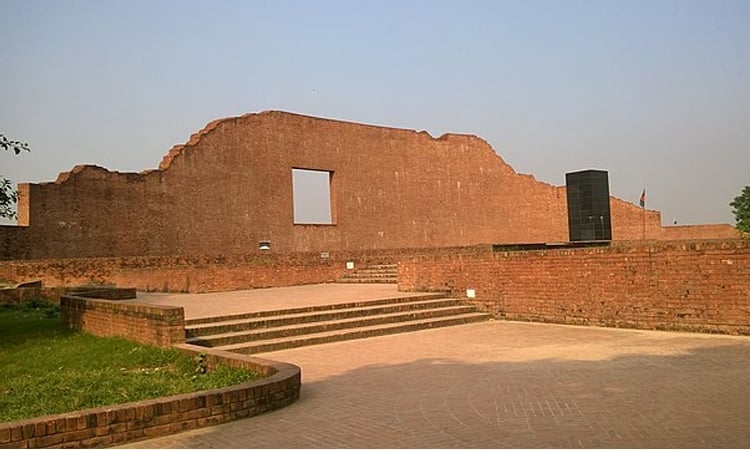Dhaka, Dec 14: The nation on Saturday observed the Martyred Intellectuals’ Day paying glowing tributes to the intellectuals who were brutally killed by the Pakistan occupation forces and their local collaborators at the fag-end of the country’s Liberation War in 1971.

The nation recalled the mass killing of a large number of Bangladesh’s top brains by the occupation forces and their collaborators visibly sensing their defeat just two days ahead of the emergence of Dhaka as the free capital of free Bangladesh.
The occupation troops and their Bengali speaking collaborators carried out a systemic killing throughout the nine months of Liberation War but the December 14 appeared to be a systematic massacre to expose the new born country to a state of brainlessness.
National programmes were taken to observe the Martyred Intellectuals Day in a befitting manner. Different political and socio-cultural organizations also took various programmes in observance of the day with due respect.
On the eve of the day, President Mohammed Shahabuddin and Chief Adviser Professor Dr Muhammad Yunus gave separate messages paying profound respect to the memories of martyred intellectuals.
As per the state programme, the president and the chief adviser placed separate wreaths at Mirpur Martyred Intellectuals Memorial in the morning.
The president and the chief adviser stood there in solemn silence for a while as a mark of profound respect to the memories of the illustrious sons of the soil. A smartly turned out contingent of the Army, Navy and Air Force offered a state salute at that time while the bugle played the last post.
Liberation War Affairs Adviser, members of the martyred families and the valiant freedom fighters including wounded freedom fighters also placed wreaths at the Intellectuals’ Memorial and Rayer Bazar killing ground to pay homage to the martyred intellectuals.
People from all walks of life, as well, started laying wreaths at the Intellectuals’ Memorial from 8.30 am.
Different television and radio channels including Bangladesh Television (BTV) and Bangladesh Betar aired special programmes while national dailies published special supplements highlighting the significance of the day.
Discussions were held at all district and upazila levels of the country while special prayers were offered at all mosques, temples, churches, pagodas and other places of worship marking the day.
Bangladesh Nationalist Party (BNP) took elaborate programme to observe the day. BNP’s Acting Chairman Tarique Rahman gave a message on the eve of the day.
To mark the day, national flag was kept half mast and black flags were hoisted atop all BNP offices across the country including central office at Nayapaltan in the capital at the dawn.
Leaders and activists of BNP and its associate and front organizations led by party secretary general Mirza Fakhrul Islam Alamgir paid tributes to the memory of martyred intellectuals by placing wreaths at the Mirpur Intellectuals’ Memorial in the morning.
Among others, BNP senior Joint Secretary General Advocate Ruhul Kabir Rizvi Ahmed, Standing Committee members Nazrul Islam Khan and Dr Abdul Mayeen Khan and convener of Dhaka city north unit Aminul Islam and BNP leader Abdus Salam were present.
After the BNP, Jatiyatabadi Juba Dal, Chhatra Dal, Swechchhasebak Dal and Krishak Dal and its associated bodies also paid respect to the martyred intellectuals.
Martyred Intellectuals Day is the most poignant day in the history of the country’s independence and struggle for freedom.
At the end of the nine-month bloody liberation war, when the people of the entire country were on the verge of final victory, the members of Razakars, Al-Badr, Al-Shams and the Peace Committee indulged in the massacre of intellectuals on that day.
This brutal massacre to deprive the nation of their intellectuals at the final moment of victory shocked the entire nation and the entire world that day.
Just two days before the surrender of the Pakistani occupation forces, on the dark night of December 14, 1971, a gang of assassins blindfolded and took about 150 intellectuals and people of various professions to an unknown location in Dhaka city alone.
That night, under the curfew, teachers, journalists, doctors, engineers, lawyers, artists-litterateurs, cultural workers and high-ranking government and private officials were dragged out of their homes by following a list. Later, they were killed and left in the silent, eerie darkness.
The next morning, many lifeless bodies were seen lying scattered in the ditches and drain of Mirpur and Rayer Bazar brickyards in Dhaka. Some were killed in bullet firing or tortured inhumanly.
Many had their hands tied behind their backs and their intestines had been removed with charging bayonets.
From the nationally published Martyred Intellectuals Day collection in 1972, news published in various publications and from the write-up of internationally renowned journalist Nicholas Tomalin at the international news magazine “Newsweek”, the total number of martyred intellectuals is as high as 1,070.
In the long liberation struggle of the people of Bangladesh, these intellectuals inspired the organizers of independence through their intellect, thinking and writing. They showed the path to liberation. They inspired the entire nation in the struggle for rights. The birth of an independent state was not tolerated by the anti-liberation clique at all.
Although December 14 is remembered as the day of the massacre of intellectuals, this most heinous crime in history actually began on December 10. Throughout the week, the names of intelligent and courageous people appeared one by one on their list.
Originally, from December 10, the listed intellectuals were blindfolded and taken from their homes to Rayer Bazar and Mirpur killing grounds in the dark of night and brutally killed.
The first Martyred Intellectuals Memorial was built in Mirpur, Dhaka in memory of the martyred intellectuals. In 1991, construction of another memorial named the Martyred Intellectuals Memorial began in Rayerbazar, Dhaka, which was inaugurated on December 14, 1999.
